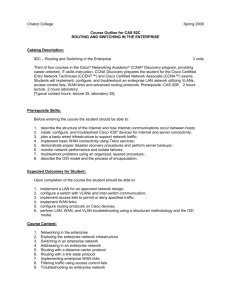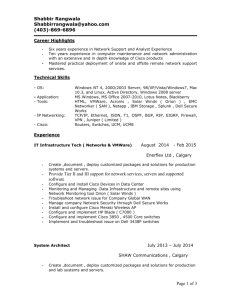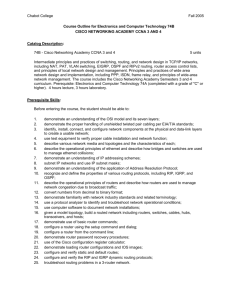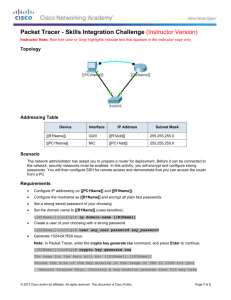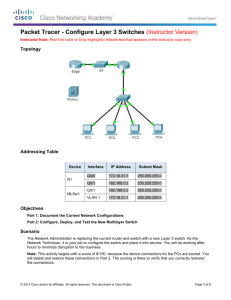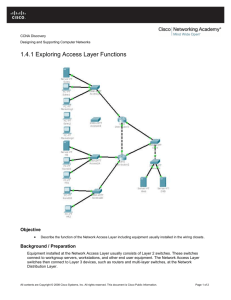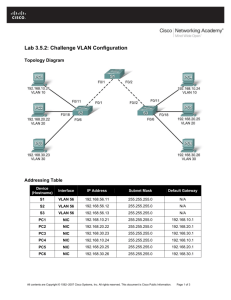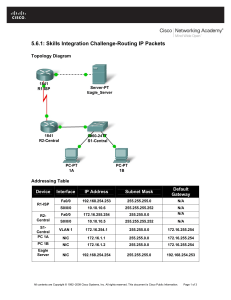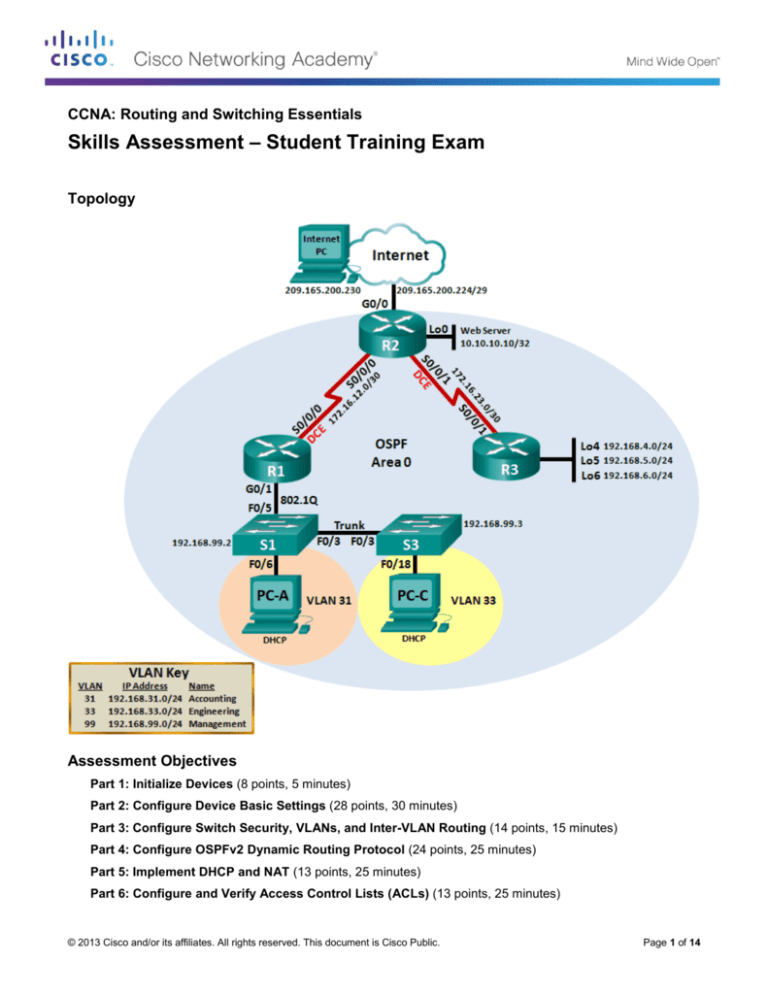
CCNA: Routing and Switching Essentials
Skills Assessment – Student Training Exam
Topology
Assessment Objectives
Part 1: Initialize Devices (8 points, 5 minutes)
Part 2: Configure Device Basic Settings (28 points, 30 minutes)
Part 3: Configure Switch Security, VLANs, and Inter-VLAN Routing (14 points, 15 minutes)
Part 4: Configure OSPFv2 Dynamic Routing Protocol (24 points, 25 minutes)
Part 5: Implement DHCP and NAT (13 points, 25 minutes)
Part 6: Configure and Verify Access Control Lists (ACLs) (13 points, 25 minutes)
© 2013 Cisco and/or its affiliates. All rights reserved. This document is Cisco Public.
Page 1 of 14
CCNA: Routing and Switching Essentials
SA Exam
Scenario
In this Skills Assessment (SA) you will configure a small network. You will configure routers, switches, and
PCs to support IPv4 connectivity, switch security, and inter VLAN routing. You will then configure the devices
with OSPFv2, DHCP, and dynamic and static NAT. Access control lists (ACLs) will be applied for added
security. You will test and document the network using common CLI commands throughout the assessment.
Required Resources
3 Routers (Cisco 1941 with Cisco IOS Release 15.2(4)M3 universal image or comparable)
2 Switches (Cisco 2960 with Cisco IOS Release 15.0(2) lanbasek9 image or comparable)
3 PCs (Windows 7, Vista, or XP with terminal emulation program, such as Tera Term)
Console cable to configure the Cisco IOS devices via the console ports
Ethernet and Serial cables as shown in the topology
Part 1: Initialize Devices
Total points: 8
Time: 5 minutes
Step 1: Initialize and reload the routers and switches.
Erase the startup configurations reload the devices.
Before proceeding, have your instructor verify device initializations.
Task
IOS Command
Points
Erase the startup-config file on all
routers.
1½ points
(½ point
per
router)
Reload all routers.
1½
points (½
point per
router)
Erase the startup-config file on all
switches and remove the old
VLAN database.
2 points
(1 point
per
switch)
Reload both switches.
2 points
(1 point
per
switch)
Verify VLAN database is absent
from flash on both switches.
1 point
(½ point
per
switch)
Instructor Sign-off Part 1: _________________________
Points: __________ of 8
© 2013 Cisco and/or its affiliates. All rights reserved. This document is Cisco Public.
Page 2 of 14
CCNA: Routing and Switching Essentials
SA Exam
Part 2: Configure Device Basic Settings
Total points: 28
Time: 30 minutes
Step 1: Configure the Internet PC.
Configuration tasks for the Internet PC include the following (Refer to Topology for IP address information):
Configuration Item or Task
Specification
Points
IP Address
(1/2 point)
Subnet Mask
(1/2 point)
Default Gateway
209.165.200.225
Note: It may be necessary to disable the PC firewall for pings to be successful later in this lab.
Step 2: Configure R1.
Configuration tasks for R1 include the following:
Configuration Item or Task
Specification
Disable DNS lookup
Points
(1/2 point)
Router name
R1
(1/2 point)
Encrypted privileged exec password
class
(1/2 point)
Console access password
cisco
(1/2 point)
Telnet access password
cisco
(1/2 point)
Encrypt the clear text passwords
(1/2 point)
MOTD banner
Unauthorized Access is Prohibited!
(1/2 point)
Interface S0/0/0
Set the description
Set the Layer 3 IPv4 address. Use the first available
address in the subnet.
Set the clocking rate to 128000
Activate Interface
(1/2 point)
Default route
Configure a default route out S0/0/0.
(1/2 point)
Note: Do not configure G0/1 at this time.
Step 3: Configure R2.
Configuration tasks for R2 include the following:
© 2013 Cisco and/or its affiliates. All rights reserved. This document is Cisco Public.
Page 3 of 14
CCNA: Routing and Switching Essentials
SA Exam
Configuration Item or Task
Specification
Disable DNS lookup
Points
(1/2 point)
Router name
R2
(1/2 point)
Encrypted privileged exec password
class
(1/2 point)
Console access password
cisco
(1/2 point)
Telnet access password
cisco
(1/2 point)
Encrypt the clear text passwords
(1/2 point)
Enable HTTP server
(1/2 point)
MOTD banner
Unauthorized Access is Prohibited!
(1/2 point)
Interface S0/0/0
Set the description
Set the Layer 3 IPv4 address. Use the next
available address in the subnet.
Activate Interface
(1 point)
Interface S0/0/1
Set the description
Set the Layer 3 IPv4 address. Use the first
available address in the subnet.
Set clocking rate to 128000
Activate Interface
(1 point)
Interface G0/0 (Simulated Internet)
Set the Description
Set the Layer 3 IPv4 address. Use the first
available address in the subnet.
Activate Interface
(1 point)
Interface Loopback 0 (Simulated Web
Server)
Set the description.
Set the Layer 3 IPv4 address.
(1/2 point)
Default route
Configure a default route out G0/0.
(1/2 point)
Step 4: Configure R3.
Configuration tasks for R3 include the following:
© 2013 Cisco and/or its affiliates. All rights reserved. This document is Cisco Public.
Page 4 of 14
CCNA: Routing and Switching Essentials
Configuration Item or Task
SA Exam
Specification
Disable DNS lookup
Points
(1/2 point)
Router name
R3
(1/2 point)
Encrypted privileged exec password
class
(1/2 point)
Console access password
cisco
(1/2 point)
Telnet access password
cisco
(1/2 point)
Encrypt the clear text passwords
(1/2 point)
MOTD banner
Unauthorized Access is Prohibited!
(1/2 point)
Interface S0/0/1
Set the description
Set the Layer 3 IPv4 address. Use the next available
address in the subnet.
Activate Interface
(1/2 point)
Interface Loopback 4
Set the Layer 3 IPv4 address. Use the first available
address in the subnet.
(1/2 point)
Interface Loopback 5
Set the Layer 3 IPv4 address. Use the first available
address in the subnet.
(1/2 point)
Interface Loopback 6
Set the Layer 3 IPv4 address. Use the first available
address in the subnet.
(1/2 point)
Default route
Configure a default route out S0/0/1.
(1/2 point)
Step 5: Configure S1.
Configuration tasks for S1 include the following:
Configuration Item or Task
Specification
Disable DNS lookup
Points
(1/2 point)
Switch name
S1
(1/2 point)
Encrypted privileged exec password
class
(1/2 point)
Console access password
cisco
(1/2 point)
Telnet access password
cisco
(1/2 point)
Encrypt the clear text passwords
MOTD banner
(1/2 point)
Unauthorized Access is Prohibited!
(1/2 point)
Step 6: Configure S3
Configuration tasks for S3 include the following:
© 2013 Cisco and/or its affiliates. All rights reserved. This document is Cisco Public.
Page 5 of 14
CCNA: Routing and Switching Essentials
SA Exam
Configuration Item or Task
Specification
Disable DNS lookup
Points
(1/2 point)
Switch name
S3
(1/2 point)
Encrypted privileged exec password
class
(1/2 point)
Console access password
cisco
(1/2 point)
Telnet access password
cisco
(1/2 point)
Encrypt the clear text passwords
MOTD banner
(1/2 point)
Unauthorized Access is Prohibited!
(1/2 point)
Step 7: Verify network connectivity.
Use the ping command to test connectivity between network devices.
Use the following table to methodically verify connectivity with each network device. Take corrective action to
establish connectivity if a test fails:
From
To
IP Address
Ping Results
Points
R1
R2, S0/0/0
(1/2 point)
R2
R3, S0/0/1
(1/2 point)
Internet PC
Default Gateway
(1/2 point)
Note: It may be necessary to disable the PC firewall for pings to be successful.
Instructor Sign-off Part 2: ______________________
Points: _________ of 28
Part 3: Configure Switch Security, VLANS, and Inter VLAN Routing
Total points: 14
Time: 15 minutes
Step 1: Configure S1.
Configuration tasks for S1 include the following:
© 2013 Cisco and/or its affiliates. All rights reserved. This document is Cisco Public.
Page 6 of 14
CCNA: Routing and Switching Essentials
Configuration Item or Task
SA Exam
Specification
Points
Create the VLAN database
Use Topology VLAN Key table to create and name
each of the listed VLANS.
(1 point)
Assign the management IP address.
Assign the Layer 3 IPv4 address to the Management
VLAN. Use the IP address assigned to S1 in the
Topology diagram.
(1/2 point)
Assign the default-gateway
Assign the first IP address in the subnet as the
default-gateway.
(1/2 point)
Force trunking on Interface F0/3
Use VLAN 1 as the native VLAN.
(1/2 point)
Force trunking on Interface F0/5
Use VLAN 1 as the native VLAN.
(1/2 point)
Configure all other ports as access
ports
Use the interface range command.
(1/2 point)
Assign F0/6 to VLAN 31
(1/2 point)
Shutdown all unused ports.
(1/2 point)
Step 2: Configure S3.
Configuration tasks for S3 include the following:
Configuration Item or Task
Specification
Points
Create the VLAN database
Use Topology VLAN Key Table to create each of the
listed VLANS. Name each VLAN.
(1 point)
Assign the management IP address.
Assign the Layer 3 IPv4 address to the Management
VLAN. Use the IP address assigned to S3 in the
Topology diagram.
(1/2 point)
Assign the default-gateway
Assign the first IP address in the subnet as the
default-gateway
(1/2 point)
Force trunking on Interface F0/3
Use VLAN 1 as the native VLAN.
(1/2 point)
Configure all other ports as access
ports
Use the interface range command.
(1/2 point)
Assign F0/18 to VLAN 33
(1/2 point)
Shutdown all unused ports.
(1/2 point)
Step 3: Configure R1.
Configuration tasks for R1 include the following:
© 2013 Cisco and/or its affiliates. All rights reserved. This document is Cisco Public.
Page 7 of 14
CCNA: Routing and Switching Essentials
SA Exam
Configuration Item or Task
Specification
Points
Configure 802.1Q subinterface .31 on
G0/1
Description Accounting LAN
Assign VLAN 31.
Assign the first available address to this interface.
(1 point)
Configure 802.1Q subinterface .33 on
G0/1
Description Engineering LAN
Assign VLAN 33.
Assign the first available address to this interface.
(1 point)
Configure 802.1Q subinterface .99 on
G0/1
Description Management LAN
Assign VLAN 99.
Assign the first available address to this interface.
(1 point)
Activate Interface G0/1
(1/2 point)
Step 4: Verify network connectivity.
Use the ping command to test connectivity between the switches and R1.
Use the following table to methodically verify connectivity with each network device. Take corrective action to
establish connectivity if a test fails:
From
To
IP Address
Ping Results
Points
S1
R1, VLAN 99 address
(1/2 point)
S3
R1, VLAN 99 address
(1/2 point)
S1
R1, VLAN 31 address
(1/2 point)
S3
R1, VLAN 33 address
(1/2 point)
Instructor Sign-off Part 2: ______________________
Points: _________ of 14
Part 4: Configure OSPFv2 Dynamic Routing Protocol
Total points: 24
Time: 25 minutes
Step 1: Configure OSPFv2 on R1.
Configuration tasks for R1 include the following:
© 2013 Cisco and/or its affiliates. All rights reserved. This document is Cisco Public.
Page 8 of 14
CCNA: Routing and Switching Essentials
SA Exam
Configuration Item or Task
Specification
Points
OSPF Process ID
1
(1/2 point)
Router ID
1.1.1.1
(1/2 point)
(1 point)
Advertise directly connected Networks
Use classless network addresses
Assign all directly connected
networks to Area 0
Set all LAN interfaces as passive
(1 point)
Change the default cost reference bandwidth to support
Gigabit interface calculations
1000
Set the serial interface bandwidth
128 Kb/s
(1 point)
Adjust the metric cost of S0/0/0
Cost: 7500
(1 point)
(1 point)
Step 2: Configure OSPFv2 on R2.
Configuration tasks for R2 include the following:
Configuration Item or Task
Specification
Points
OSPF Process ID
1
(1 point)
Router ID
2.2.2.2
(1 point)
Advertise directly connected Networks
Use classless network addresses
Note: Omit the G0/0 network.
(1 point)
Set the LAN (Loopback) interface as passive
(1 point)
Change the default cost reference bandwidth to allow for
Gigabit interfaces
1000
Set the bandwidth on all serial interfaces
128 Kb/s
(1 point)
Adjust the metric cost of S0/0/0
Cost: 7500
(1 point)
(1 point)
Step 3: Configure OSPFv2 on R3.
Configuration tasks for R3 include the following:
© 2013 Cisco and/or its affiliates. All rights reserved. This document is Cisco Public.
Page 9 of 14
CCNA: Routing and Switching Essentials
SA Exam
Configuration Item or Task
Specification
Points
OSPF Process ID
1
(1/2 point)
Router ID
3.3.3.3
(1/2 point)
(1 point)
Advertise directly connected Networks
Use classless network addresses
Assign interfaces to Area 0
Use a single summary address for
the LAN (loopback) interfaces.
Set all LAN (Loopback) interfaces as passive
(1 point)
Change the default cost reference bandwidth to
support Gigabit interface calculations
1000
Set the serial interface bandwidth
128 Kb/s
(1 point)
(1 point)
Step 4: Verify OSPF information.
Verify that OSPF is functioning as expected. Enter the appropriate CLI command to discover the following
information:
Question
Response
Points
What command will display all connected OSPFv2 routers?
(1 point)
What command displays a summary list of OSPF interfaces
that includes a column for the cost of each interface?
(1 point)
What command displays the OSPF Process ID, Router ID,
Address summarizations, Routing Networks, and passive
interfaces configured on a router?
(1 point)
What command displays only OSPF routes?
(1 point)
What command displays detail information about the OSPF
interfaces, including the authentication method?
(1 point)
What command displays the OSPF section of the runningconfiguration?
(1 point)
Instructor Sign-off Part 3: ______________________
Points: _________ of 24
Part 5: Implement DHCP and NAT for IPv4
Total points: 13
Time: 25 minutes
Step 1: Configure R1 as the DHCP server for VLANs 31 and 33.
Configuration tasks for R1 include the following:
© 2013 Cisco and/or its affiliates. All rights reserved. This document is Cisco Public.
Page 10 of 14
CCNA: Routing and Switching Essentials
SA Exam
Configuration Item or Task
Specification
Points
Reserve the first 20 IP addresses in
VLAN 31 for static configurations
(1 point)
Reserve the first 20 IP addresses in
VLAN 33 for static configurations
(1 point)
Create a DHCP pool for VLAN 31
Name: ACCT
DNS-Server: 10.10.10.11
Domain-Name: ccna-sba.com
Set the default gateway.
(1 point)
Create a DHCP pool for VLAN 33
Name: ENGNR
DNS-Server: 10.10.10.11
Domain-Name: ccna-sba.com
Set the default gateway.
(1 point)
Step 2: Configure Static and Dynamic NAT on R2.
Configuration tasks for R2 include the following:
Configuration Item or Task
Create a local database with 1 user
account
Specification
Username: webuser
Password: cisco12345
Privilege level: 15
Points
(1 point)
Enable HTTP server service
(1/2 point)
Configure the HTTP server to use the
local database for authentication
(1/2 point)
Create a static NAT to the Web Server
Inside Global Address: 209.165.200.229
Assign the inside and outside interface
for the static NAT
(1 point)
(1 point)
Configure the dynamic NAT inside
private ACL
Access List: 1
Allow the Accounting and Engineering networks on
R1 to be translated.
Allow a summary of the LANs (loopback) networks
on R3 to be translated.
(1 point)
Define the pool of usable public IP
addresses
Pool Name: INTERNET
Pool of addresses include:
209.165.200.225 – 209.165.200.228
(1 point)
Define the dynamic NAT translation
© 2013 Cisco and/or its affiliates. All rights reserved. This document is Cisco Public.
(1 point)
Page 11 of 14
CCNA: Routing and Switching Essentials
SA Exam
Step 3: Verify DHCP and Static NAT.
Use the following tasks to verify that DHCP and Static NAT settings are functioning correctly. It may be
necessary to disable the PC firewall for pings to be successful:
Test
Results
Points
Verify that PC-A acquired IP
information from the DHCP
server
(1/2 point)
Verify that PC-C acquired IP
information from the DHCP
server
(1/2 point)
Verify that PC-A can ping PC-C.
Note: It may be necessary to
disable the PC firewall
(1/2 point)
Use a Web browser on the
Internet PC to access the Web
server (209.165.200.229). Login
with Username: webuser,
Password: cisco12345
(1/2 point)
Note: Verification of dynamic NAT will be performed in Part 6.
Instructor Sign-off Part 2: ______________________
Points: _________ of 13
Part 6: Configure and Verify Access Control Lists (ACLs)
Total points: 13
Time: 25 minutes
Step 1: Restrict access to VTY lines on R2.
Configuration Item or Task
Configure a named access list to only allow R1 to telnet to R2.
Specification
ACL Name: ADMIN-MGT
Points
(2 points)
Apply the named ACL to the VTY lines
(1 point)
Verify ACL is working as expected,
(1 point)
Step 2: Secure the network from Internet traffic.
© 2013 Cisco and/or its affiliates. All rights reserved. This document is Cisco Public.
Page 12 of 14
CCNA: Routing and Switching Essentials
SA Exam
Configuration Item or Task
Specification
ACL No.: 101
Configure an Extended ACL to:
Allow Internet hosts WWW access to the simulated
web server on R2 by accessing the static NAT
address (209.165.200.229) that you configured in
Part 3.
Prevent traffic from the Internet from pinging
internal networks, while continuing to allow LAN
interfaces to ping the Internet PC.
Apply ACL to the appropriate interface(s)
Points
(2
points)
(1 point)
Verify ACL is working as expected
From the Internet PC:
Ping PC-A (Pings should
be unreachable.)
Ping PC-C (Pings should
be unreachable.)
(1 point)
From R1, Ping the Internet PC
(Pings should be successful.)
Note: It may be necessary to disable the PC firewall for pings to be successful.
Step 3: Enter the appropriate CLI command needed to display the following:
Command Description
Student Input (command)
Points
Display the matches an access-list
has received since the last reset.
(1 point)
Reset access-list counters.
(1 point)
What command is used to display
what ACL is applied to an
interface and the direction that it is
applied
(1 point)
What command displays the NAT
translations?
Note: The translations for PC-A and PC-C were added to
the table when the Internet PC attempted to ping these
PCs in Step 2. Pinging the Internet PC from PC-A or PCC will not add the translations to the table because of the
way the Internet is being simulated on the network.
What command is used to clear
dynamic NAT translations?
(1 point)
(1 point)
Instructor Sign-off Part 4: ______________________
Points: _________ of 13
© 2013 Cisco and/or its affiliates. All rights reserved. This document is Cisco Public.
Page 13 of 14
CCNA: Routing and Switching Essentials
SA Exam
Part 7: Cleanup
NOTE: DO NOT PROCEED WITH CLEANUP UNTIL YOUR INSTRUCTOR HAS GRADED YOUR SKILLS
EXAM AND HAS INFORMED YOU THAT YOU MAY BEGIN CLEANUP.
Before turning off power to the routers, remove the NVRAM configuration files (if saved) from all devices.
Disconnect and neatly put away all cables that were used in the Final.
Router Interface Summary Table
Router Interface Summary
Router Model
Ethernet Interface #1
Ethernet Interface #2
Serial Interface #1
Serial Interface #2
1800
Fast Ethernet 0/0
(F0/0)
Fast Ethernet 0/1
(F0/1)
Serial 0/0/0 (S0/0/0)
Serial 0/0/1 (S0/0/1)
1900
Gigabit Ethernet 0/0
(G0/0)
Gigabit Ethernet 0/1
(G0/1)
Serial 0/0/0 (S0/0/0)
Serial 0/0/1 (S0/0/1)
2801
Fast Ethernet 0/0
(F0/0)
Fast Ethernet 0/1
(F0/1)
Serial 0/1/0 (S0/1/0)
Serial 0/1/1 (S0/0/1)
2811
Fast Ethernet 0/0
(F0/0)
Fast Ethernet 0/1
(F0/1)
Serial 0/0/0 (S0/0/0)
Serial 0/0/1 (S0/0/1)
2900
Gigabit Ethernet 0/0
(G0/0)
Gigabit Ethernet 0/1
(G0/1)
Serial 0/0/0 (S0/0/0)
Serial 0/0/1 (S0/0/1)
Note: To find out how the router is configured, look at the interfaces to identify the type of router and how many
interfaces the router has. There is no way to effectively list all the combinations of configurations for each router
class. This table includes identifiers for the possible combinations of Ethernet and Serial interfaces in the device.
The table does not include any other type of interface, even though a specific router may contain one. An
example of this might be an ISDN BRI interface. The string in parenthesis is the legal abbreviation that can be
used in Cisco IOS commands to represent the interface.
© 2013 Cisco and/or its affiliates. All rights reserved. This document is Cisco Public.
Page 14 of 14

